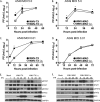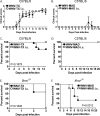Infectious clones of novel lineage 1 and lineage 2 West Nile virus strains WNV-TX02 and WNV-Madagascar
- PMID: 22573862
- PMCID: PMC3416286
- DOI: 10.1128/JVI.00401-12
Infectious clones of novel lineage 1 and lineage 2 West Nile virus strains WNV-TX02 and WNV-Madagascar
Abstract
We report the generation of West Nile virus (WNV) infectious clones for the pathogenic lineage 1 Texas-HC2002 and nonpathogenic lineage 2 Madagascar-AnMg798 strains. The infectious clones exhibited biological properties similar to those of the parental virus isolates. We generated chimeric viruses and found that viral factors within the structural and nonstructural regions of WNV-TX contribute to the control of type I interferon defenses. These infectious clones provide new reagents to study flavivirus immune regulation and pathogenesis.
Figures




References
-
- Beasley DW, Li L, Suderman MT, Barrett AD. 2002. Mouse neuroinvasive phenotype of West Nile virus strains varies depending upon virus genotype. Virology 296:17–23 - PubMed
-
- Berthet FX, et al. 1997. Extensive nucleotide changes and deletions within the envelope glycoprotein gene of Euro-African West Nile viruses. J. Gen. Virol. 78(Pt 9):2293–2297 - PubMed
-
- Centers for Disease Control and Prevention 2011. West Nile virus disease and other arboviral diseases—United States, 2010. MMWR Morb. Mortal. Wkly. Rep. 60:1009–1013 - PubMed
-
- Clarke JB, Spier RE. 1983. An investigation into causes of resistance of a cloned line of BHK cells to a strain of foot-and-mouth disease virus. Vet. Microbiol. 8:259–270 - PubMed
Publication types
MeSH terms
Substances
Grants and funding
LinkOut - more resources
Full Text Sources
Other Literature Sources
Medical

